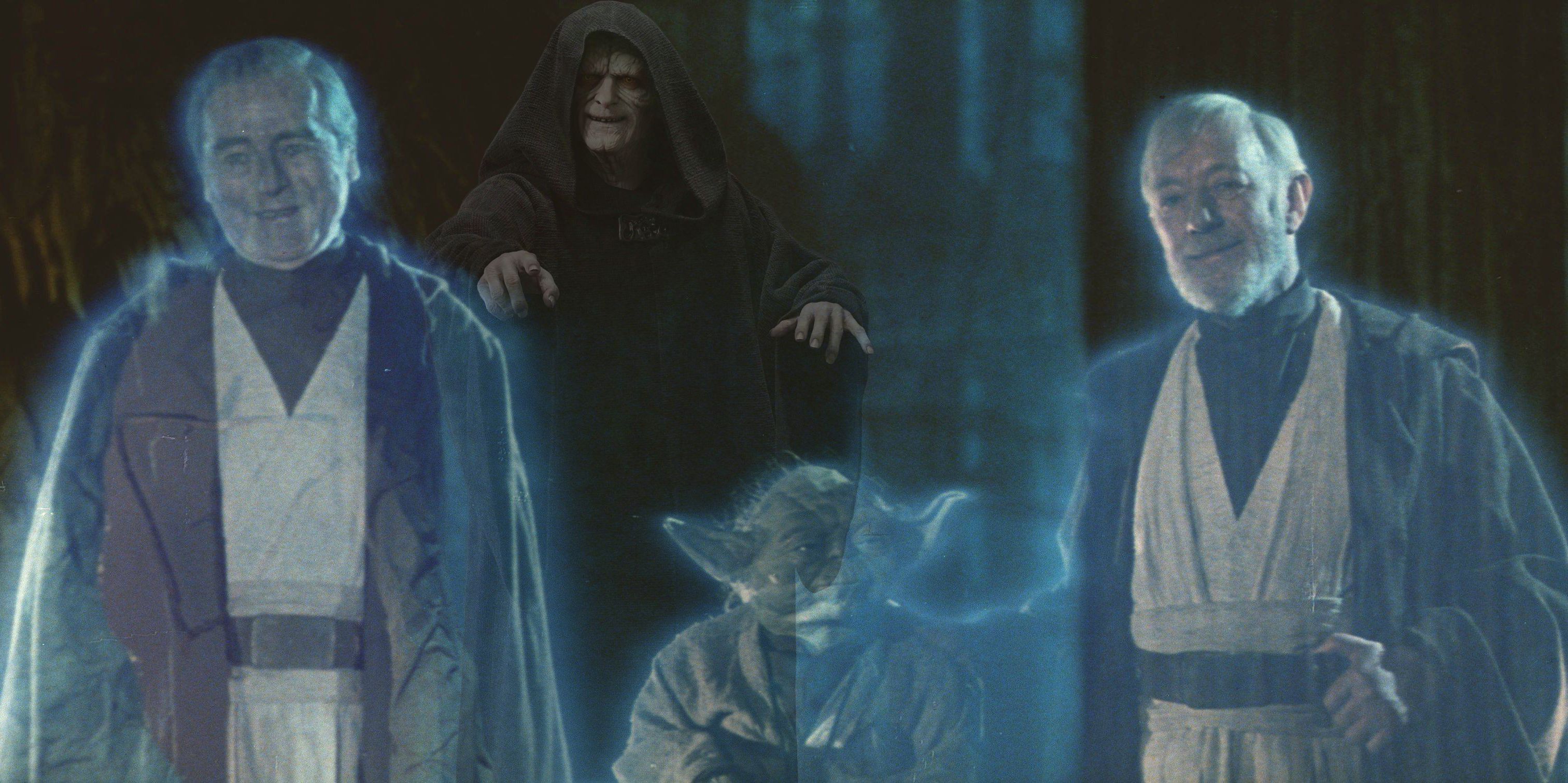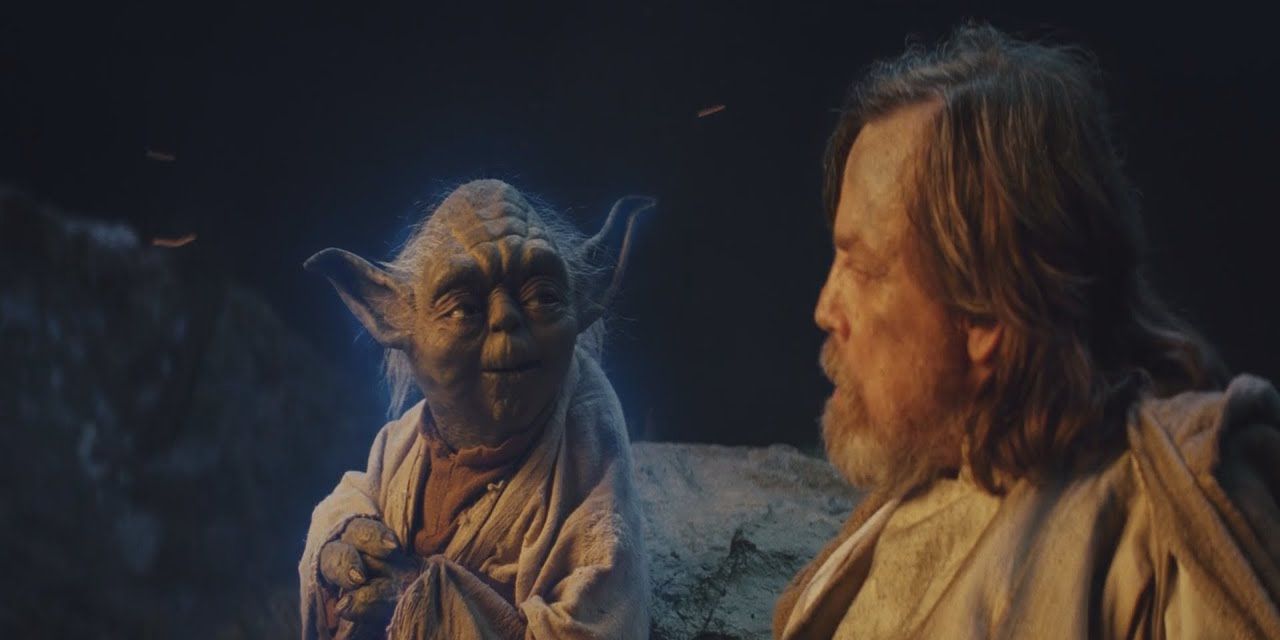Although some say Sith cannot come back as Force Ghosts in the Star Wars universe, they totally can. Legends Lore was littered with Sith and Dark Jedi who had learned the technique, and even Anakin returned as a Force Ghost at the end of Return of the Jedi. With Palpatine’s return in The Rise of Skywalker, it seems like a good time to explore the rules governing Force Users after death.
The majority of Force Users (unless they are protagonists) die normal deaths. Post Phantom Menace, Jedi tend to become one with the Force, body and all, though there's one exception we'll get to a bit later. Sith prefer to remain in this plane of existence, even if that means being tied to an object or location for extremely long periods.
Qui-Gon Jinn is the first Jedi shown to master becoming a Force Ghost. He learned the technique from the Priestesses of the Force, but Darth Maul killed him before he could complete his training. His body remained in Naboo, and it took him a long time to go from an incorporeal voice, to a grey blob, to finally, in the short story Master and Apprentice by Claudia Gray, a fully materialized Force Ghost. Later on, Obi-Wan learns this technique, and Clone Wars Yoda has his own quest to learn how to become one with the Force as well.
The first takeaway is that becoming one with the Force is easy for a Jedi: one just has to let go, and join a plane where there are no timelines, no separation and no otherness of any kind. It is coming back as a Force Ghost that is painful and hard because it implies abandoning that blissful state.
This ties in with the idea that only true selflessness in service of the Force allows Force Users to become true Jedi. In the novelization of The Last Jedi, Rey is able to survive the throne room battle because she surrenders to the Force and lets it guide her. In Legends, padawan Githany is incapable of becoming a Jedi (and eventually turns Dark) because she is terrified by the vastness of the Force and fears she'll lose herself in it. Githany’s fear was not baseless: it is what happens to almost every single being upon death, and this loss of the sense of self is one of the main fears in real life as well.
The Sith, who seek to absorb and manipulate the Force, tailoring it to serve their will and to make them different, unique and individually powerful. It is the core of their power, so it is understandable that a Sith would approach the idea of dying much differently than a Jedi. Sith do not seek to become one with the Force; they want to stay in this plane and keep their own minds to have the chance to live and rule again in the future. To accomplish this, they master the ultimate separation: that of their spirit and their body, so that their spirit does not depend on their physical body to survive, but it can attach itself to any physical object. If the Sith is powerful enough, they can continue to influence the living when the haunted object is touched. That, of course, is the ultimate perversion of the Force: using it to overpower the spirit of another sentient being.
Canon Star Wars comic series Darth Vader: Dark Lord of the Sith by Charles Soule explores this concept. Heretic Sith Momin repeatedly possesses Imperial personnel and Mustafar inhabitants with his mask while retaining his full mental abilities, will and Force power. Darth Vader tries to use Momin to open a portal to the afterlife, hoping to bring Padmé back. Momin is able to succeed in the endeavor.
However, Momin was a rare beast even among the Sith, and he was a heretic for a reason. He understood the Force like a Jedi, as something that one submits to, although coupled with a much more sinister vision. Momin’s inner balance might be why he succeeded in connecting with the realm of the dead: he was not afraid of letting himself go to offer his “creations” to the Force.
Interestingly enough, the “light” Jedi ghosts have to perform an act of “Sithian” selfishness to attain this separation from the Force and to manifest in the mortal realm. There’s a massive difference between Qui-Gon Jinn’s “voice” manifestation at the beginning of the saga and the way Yoda’s Force Ghost sets fire to a tree in The Last Jedi. Yoda’s understanding of balance was better at the time of his death than Qui-Gon’s, which suggests that being able to come back as a Force Ghost has less to do with being a Jedi and more with being able to balance between the individual spirit (the self) and the whole of the Universe (the Force.)
Force Ghosts can teach this lesson to other Force Ghosts, which is why Anakin’s Ghost, guided by Obi-Wan and Yoda, was present at the end of The Return of the Jedi. Luke died in an almost perfect balance, so logically we should expect his spirit to be that much more powerful in The Rise of Skywalker.
So what does that mean for Palpatine? His spirit definitely survived the destruction of the Death Star II, and throughout the sequel trilogy, we have seen objects associated with him (Darth Vader’s mask, Snoke’s ring) which suggests that he managed to attach himself to an object. It might be he's bound himself to the Death Star itself – or it might be the rumored Wayfinder device that Kylo Ren and his Knights will be questing for in The Rise of Skywalker. It's also entirely possible he's mastered some technique to manifest as a Force Ghost, since it's entirely possible for him to do so. One thing is for sure: Palpatine is the ultimate Sith even in death, and he will try to take over the first warm body that is available to him. Let’s hope he doesn’t succeed.
Directed and co-written by J.J. Abrams, Star Wars: The Rise of Skywalker stars Daisy Ridley, Adam Driver, John Boyega, Oscar Isaac, Lupita Nyong’o, Domhnall Gleeson, Kelly Marie Tran, Joonas Suotamo, Billie Lourd, Keri Russell, Matt Smith, Anthony Daniels, Mark Hamill, Billy Dee Williams and Carrie Fisher, with Naomi Ackie and Richard E. Grant. The film arrives on Dec. 20.


